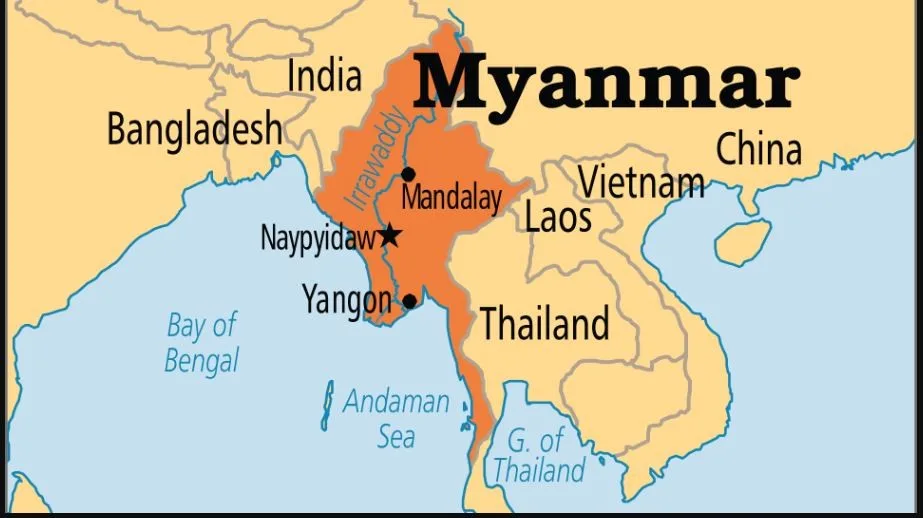Syllabus: GS2/IR/GS3/Internal Security
Context
- In 2024, the Union Home Minister announced that the Free Movement Regime (FMR) along the Myanmar border would be scrapped but there hasn’t been any progress yet.
Free Movement Regime
- The FMR is a mutually agreed arrangement between the two countries that allows tribes living along the border to travel inside the other country without a visa.
- The FMR with Myanmar came into existence in 1968 as people on either side of the border have familial and ethnic ties.
- The territorial limit of free movement then was 40 km, which was reduced to 16 km in 2004, and additional regulations were enforced in 2016.
Reasons for Scrapping FMR
- Threat to internal security: The instability in Myanmar, coupled with the presence of armed groups, poses a significant challenge for India in terms of cross-border migration and internal security.
- Drug Trafficking: The drugs that are coming in from the Golden Triangle, a region where the jungle borders of Thailand, Laos, and Myanmar meet and which is one of the world’s main illicit drug production and trafficking areas,
- Insurgent Groups: The prevailing arrangement allows insurgents to have camps in the dense jungles of Myanmar across the border.
- Refugees Influx: There are a large number of refugees moving into the northeastern (NE) states, primarily in Manipur.
- China’s Influence: Myanmar’s dependence on China grew post-coup in 2021, with China shielding Myanmar from international criticism, though Myanmar had sought diversification pre-coup.
Brief on India- Myanmar Relations
- Location: India shares a long land border with Myanmar as well as a maritime boundary in the Bay of Bengal.
- Four northeastern states, viz., Arunachal Pradesh, Nagaland, Manipur and Mizoram, have a boundary with Myanmar.

- Diplomatic Relations: Diplomatic relations between India and Myanmar have generally been friendly, with high-level visits and engagements strengthening ties at the governmental level.
- India and Myanmar signed a Treaty of Friendship in 1951.
- Historical and Cultural Ties: Both Nations share deep historical and cultural connections, with influences from Buddhism, Hinduism, and trade routes shaping their interactions over millennia.
- Geopolitical Significance: Myanmar holds significant geopolitical importance for India due to its strategic location, acting as a bridge between South Asia and Southeast Asia.
- India is seeking to enhance its cooperation with Myanmar in line with ‘Act East’ and ‘Neighborhood First’ Policies.
- Economic Cooperation: Economic cooperation between the two nations has been steadily growing since the trade agreement in 1970, with India being one of Myanmar’s largest trading partners.
- The bilateral trade stood at US$ 1.50 billion in 2023-24. Bilateral trade is conducted under ASEAN-India Trade in Goods Agreement (AITIGA) and India’s Duty Free Tariff Preference (DFTP) scheme.
- Security Cooperation: Both countries share concerns over border security, insurgency, and cross-border trafficking.
- They have cooperated on security issues, including intelligence sharing and joint patrolling along the border.
- Connectivity Projects: India is involved in various connectivity projects aimed at improving infrastructure and connectivity between the two countries.
- The Kaladan Multi-Modal Transit Transport Project and the India-Myanmar-Thailand Trilateral Highway are notable examples.
- Sittwe Port in Myanmar’s Rakhine Province is crucial for the Kaladan Multi-Modal Transit Transport Project (KMMTTP).
- Development Assistance: India has been providing development assistance to Myanmar in various sectors, including infrastructure, healthcare, education, and capacity building.
- Shared Platforms: BIMSTEC, Mekong-Ganga Cooperation (MGC).
Conclusion
- The political situation is unpredictable in Myanmar, India needs to establish a certain mechanism to check the flow of people from Myanmar to India.
- The government needs to educate the people in India about the problems in the region, take the people into confidence, and arrive gradually at a decision.
Source: TH
Previous article
Battling Money Laundering & Terrorist Financing